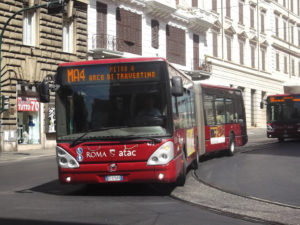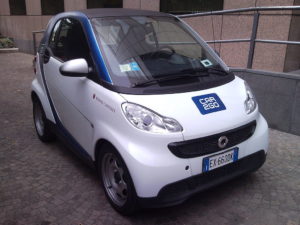ATAC

ATAC is the Roman transport company. Notorious for its unreliability and lack of transparency, ineffectiveness is also a problem. (Confessio p.64)
[…] In any case, the Romans are able to deal with their infrastructure with a sense of fate. The Romans have understood that their principle of life “courage et patience” stands especially for their traffic system: courage is necessary when one is on the roads, because generally cars are driven by sight and not by rules. But if you stand up for your position with courage, you can move forward without any problems. On the other hand, patience is necessary when travelling with ATAC (Aziende Tramvie ed Autobus del Comune di Roma). A popular joke is that the Roman transport company ATAC actually stands for: “I’m late home!”
This is certainly not wrong, but ATAC also has to contend with many challenges: first, there is Rome’s plodding traffic, which brings the city to a standstill, especially during the rush hours of 8am to 10am or 5pm to 8pm. Then there is ATAC itself, a corrupt, poor, non-transparent and diva-like transport company that also requires a lot of patience. Buses, trams as well as metros are designed to be overcrowded. There are few seats and a lot of standing room, so that less ATAC and more overcrowding is possible. From October at the latest, when all Romans are back from their holidays and working full time again, the constant challenge of overcrowding has to be dealt with. And finally, thirdly, there are the countless strikes, the strikes that are held at least once a month.
These, too, are difficult to understand, as sometimes only individual lines go on strike, leaving it unclear who is running and who is not. But the Romans can also come to terms with this: “Why does a real Roman always have two lovers? Because one is always on strike.” And despite everything, one has to agree with Cardinal Antonelli and thank God that Rome’s infrastructure is the way it is. It gives one an excuse for lateness in all Roman circumstances. No matter where you’re late, you can always point to ATAC and get an understanding, “Yeah, this city doesn’t work.” Moreover, ATAC works comparatively well, especially at night when traffic is quiet; so, the Diva loves night owls. And finally, Roman traffic opens up deeply religious dimensions for all of us: it is precisely here that we experience contingency, precisely here that we sense that we do not have everything in our hands, that we are utterly dependent. May we give thanks to God for this!
(Loci Romani, p. 12)
BYCICLE

[…] Cycling in Rome is not exactly easy and requires walking the fine line between fearless megalomania and cautious respect, coupled with great calm and concentration. I used to make three crosses when I crossed Berlin’s Oranienstrasse alive; after the joyous traffic anarchy of the Piazza Venezia, it seems cute. Regularly, the only thing that helped against a swerving bus or a taxi overtaking on the right was to jump onto the pavement. And the Roman slopes are not to be sneezed at either: It’s the city of the seven hills, and you rarely realize that as much as you do on a bike.
But if you don’t let yourself, be put off by all these nightmares, you will be rewarded, in my opinion, with the most beautiful cycling scenery in the world. I lived in the San Giovanni district and will never forget my morning routes: Either up the Aventine past the Baths of Caracalla and the Circo Massimo, or up the horrible incline of the Celio to the Colosseum, then along the Via dei Fori Imperiali to the Piazza Venezia and into the centre. When this feeling of roaring through the Roman Forum with the Roman wind in your hair has become part of everyday life, it’s not so easy to get used to Berlin’s Oranienstraße again. Cycling is more efficient anyway: by train it would have taken me more than twice as long to cover most of the distances. That’s a lot of hours saved that can be invested in Rome’s great libraries, museums and ice cream parlours. I felt like I was saying goodbye to a loyal friend when I returned the bike at the end of the academic year – and will certainly pay it a visit on my next stay.
(Loci Romani p. 29)
CAR SHARING

If ATAC doesn’t drive or drives too slowly again and for whom cycling seems more like suicide, you can use one of the city’s two car-sharing services: car2go or enjoy. Car2go is a Daimler AG company. Once registered, you can use the app to see where there are cars everywhere in the city. Right next to the student hostel in Via Aurelia in the Crowne Plaza car park there is a collective car park for car2gos, where there is usually a car available. There are three types of cars: Smart fortwo, Smart for four and Smart Cabrio. All are automatic. Charging is per minute, with the per-minute rate varying from 19ct to 31ct per minute, depending on the type of vehicle. There is usually no parking space in the city centre, which is why trips to the outskirts are the best option. From Aurelio to Ostiense and Testaccio, where most of the nightlife takes place, it takes about 15 minutes at night with an open road, while by day you have to allow at least an hour by metro. Almost all the cars are more or less scratched and if the car shows some defects while driving: don’t worry. After a worried call on my part to the car2go hotline, the employee reassured me by saying that all discarded vehicles from Germany are taken to Italy and Spain, so I shouldn’t worry, it would be normal.
